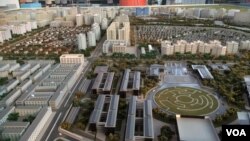What if a street lamp could alert the authorities when the bulb goes out so they could fix it? Or, what if a smartphone app could let drivers know which streets are flooded? Some cities are already rolling out such technology, which systematizes the way they manage everything from crime to health care to trash collection.
Now, one local government in Vietnam is looking to hitch itself to this “smart cities” bandwagon.
Binh Duong province recently invited experts to the Smart City Summit to generate ideas on how it could govern more efficiently through innovation.
Some discussed self-driving cars, which could be folded into public transit, so that residents would give up private vehicles and shrink their carbon footprints. Others suggested software that would tell ambulance drivers which nearby hospitals have beds available or doctors specializing in treatment the patient requires.
The theme was to mechanize more public services. In this way, cities become smarter, like living organisms that can respond to residents’ needs. Functions once performed by bureaucrats can increasingly be transferred to robots and devices.
Beyond public services, a smart urban blueprint would tackle construction.
Pham Tuan Khoa, a green building services manager at the engineering firm Tebodin, noted that Singapore set a target for 80 percent of buildings to be green by 2030.
That might not be realistic for less affluent Vietnam, but Khoa said it could start small, by adding insulation to buildings to improve energy efficiency, or eventually by installing lights that dim when they detect sufficient sunlight in a room.
“People should be aware, what they’re doing is not good for the environment,” he said on the sidelines of the conference. “So from my perspective, the most easy way to come at it is to create an incentive from the government. If the government pushes top-down, it becomes a standard, it becomes a must.”
Binh Duong has signed a memo of understanding with the Dutch city Eindhoven as a consultant on smart development.
Peter Portheine, director of the Dutch think tank Brainport Development, said he has “started to see some similarities” between the two regions. For example, Eindhoven transitioned from manufacturing to a knowledge economy that runs on automation, which is what Binh Duong is now hoping to do.
But it also has a greenfield advantage, in that Vietnam remains an emerging market less bogged down by legacy systems and infrastructure.
“Binh Duong doesn’t have to invent the wheel itself, it can share many experiences from Eindhoven, but also from other regions in Asia,” Portheine said in a speech at the summit, which was co-organized by the Dutch government. “So we can bring together the best of many worlds to make sure that we are not making the same mistakes as we did in Eindhoven.”
Tapping into smart innovation could get Binh Duong People's Committee chairman Tran Thanh Liem closer to his goal of creating a high-tech destination.
“After nearly 20 years of reestablishment, industrialization, and modernization, Binh Duong has turned from an agricultural province to an industrial one,” Liem said in the keynote speech.
Binh Duong is facing some stiff competition, however. Neighboring Ho Chi Minh City is the country’s commercial engine. The central city of Danang also wants to be a tech hub and boasts a port to facilitate trade. Then there’s Hanoi, which receives twice as many foreign-investment projects.
But Binh Duong has still become a top contributor to Vietnam’s gross domestic product by actively courting foreign investors to its many industrial parks. The city has also experimented with reforms to improve the living environment, creating a new center now dubbed the Binh Duong New City.







